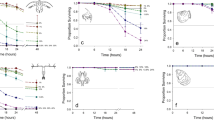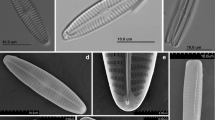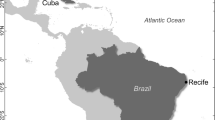Abstract
Marine phytoplankton have been shown to use chemical feeding deterrents to reduce or inhibit zooplankton grazing. In order to screen phytoplankton species for feeding deterrent production and to isolate and identify feeding deterrent compounds, a new, rapid, and reliable laboratory bioassay was developed. This bioassay used the laboratory-reared harpacticoid copepod Tigriopus californicus and measured inhibition of feeding by measuring the fecal pellet production rate. The bioassay was capable of detecting deterrent compounds: (1) adsorbed onto ground fish food (a normally palatable food); (2) dissolved in a mixture of seawater and live Thalassiosira pseudonana cells (a species of diatom which had no feeding deterrent activity); and (3) present in live cell cultures. Method (2) was recommended for use in bioassay-guided fractionation (isolation of chemical compounds), as it was reliable, rapid, accurate, and easy to perform with large numbers of samples. The total bioassay time was < 48 h, and data collection required only a microscope. Methanolic cell extracts of several phytoplankton species were screened for feeding deterrent activity. Extracts from the diatom Phaeodactylum tricornutum and the dinoflagellate Gonyaulax grindleyi gave feeding deterrent responses, while extracts from the diatom Thalassiosira pseudonana gave no feeding deterrent responses. Live P. tricornutum cells deterred feeding at densities of 6x105 cells ml-1. This bioassay should provide a valuable tool in screening phytoplankton for feeding deterrent compounds and determining the chemical nature of these compounds.
Similar content being viewed by others
References
Ali RM (1970) The influence of suspension density and temperature on the filtration rate of Hiatella arctica. Mar Biol 6:291–302
Ayukai T (1987) Discriminate feeding of the calanoid copepod Acartica clausi in mixtures of phytoplankton and inert particles. Mar Biol 94:579–587
Ayukai T, Nishizawa S (1986) Defecation rate as a possible measure of ingestion rat of Calanus pacificus pacificus (Copepoda: Calanoida). Bull Plankton Soc Japan 33:3–10
Bell WH, Mitchell R (1972) Chemotactic and growth responses of marine bacteria to algal extracellular products. Biol Bull mar biol Lab, Woods Hole 143:265–277
Burton RS, Feldman MW, Curtsinger JW (1979) Population genetics of Tigriopus californicus (Copepoda Harpacticoida): I. Population structure along the central California coast. Mar Ecol Prog Ser 1:29–39
Chotiyaputta C, Hirayama K (1978) Food selectivity of the rotifer Brachionus plicatilis feeding on phytoplankton. Mar Biol 45:105–111
Craigie JS, McLachlan J (1964) Excretion of colored ultraviolet-absorbing substances by marine algae. Can J Bot 42:23–33
DeMott WR, Zhang QX, Carmichael WW (1991) Effects of toxic cyanobacteria and purified toxins on the survival and feeding of a copepod and three species of Daphnia. Limnol Oceanogr 36:1346–1357
Dethier MN (1980) Tidepools as refuges: predation and the limits of the harpacticoid copepod Tigriopus californicus (Baker). J exp mar Biol Ecol 42:99–111
Egloff DA (1986) Effects of Olisthodiscus luteus on the feeding and reproduction of the marine rotifer Synchaeta cecilia. J Plankton Res 8:263–274
Epifanio CE, Valenti CC, Turk CL (1981) A comparison of Phaeodactylum tricornutum and Thalassiosira pseudonana as foods for the oyster, Crassostrea virginica. Aquaculture, Amsterdam 23: 347–353
Harrison PJ, Waters RE, Taylor FJR (1980) A broad spectrum artificial seawater medium for coastal and open ocean phytoplankton. J Phycol 16:28–35
Huntley ME (1982) Yellow water in La Jolla Bay, California, July 1980. II. Suppression of zooplankton grazing. J exp mar Biol Ecol 63:81–91
Huntley ME, Barthel K-G, Star JL (1983) Particle rejection of Calanus pacificus: discrimination between similarly sized particles. Mar Biol 74:151–160
Huntley M, Sykes P, Rohan S, Marin V (1986) Chemically-mediated rejection of dinoflagellate prey by the copepods Calanus pacificus and Paracalanus parvus: mechanism, occurrence, and significance. Mar Ecol Prog Ser 28:105–120
Sherr EB, Sherr BF, McDaniel J (1991) Clearance rates of <6 μm fluorescently labeled algae (FLA) by estuarine protozoa: potential grazing impact of flagellates and ciliates. Mar Ecol Prog Ser 69:81–92
Sullivan DS, Bisalputra T (1980) The morphology of a harpacticoid gut: a review and synthesis. J Morphol 164:89–105
Sykes PF, Huntley ME (1987) Acute physiological reactions of Calanus pacificus to selected dinoflagellates: direct observations. Mar Biol 94:19–24
Tsuda A, Nemoto T (1990) The effect of food concentration on the fecal pellet size of the marine copepod Pseudocalanus newmani Frost. Bull Plankton Soc Japan 37:83–90
Uye S, Takamatsu K (1990) Feeding interactions between planktonic copepods and red-tide flagellates from Japanese coastal waters. Mar Ecol Prog Ser 59:97–107
Verity PG, Stoecker D (1982) Effects of Olisthodiscus luteus on the growth and abundance of tintinnids. Mar Biol 72:79–87
Ward E, Targett NM (1989) Influence of marine microalgal metabolites on the feeding behavior of the blue mussel Mytilus edulis. Mar Biol 101:313–321
Wilkinson GN (1961) Statistical estimations in enzyme kinetics. Biochem J 80:324–332
Wootton LS (1989) Salt-flocculated organic material as a food source in estuarine food webs. M. Sc. Thesis, University of British Columbia, Vancouver, British Columbia
Author information
Authors and Affiliations
Additional information
Communicated by R. J. Thompson, St. John's
Rights and permissions
About this article
Cite this article
Shaw, B.A., Harrison, P.J. & Andersen, R.J. Evaluation of the copepod Tigriopus californicus as a bioassay organism for the detection of chemical feeding deterrents produced by marine phytoplankton. Marine Biology 121, 89–95 (1994). https://doi.org/10.1007/BF00349477
Received:
Accepted:
Issue Date:
DOI: https://doi.org/10.1007/BF00349477




